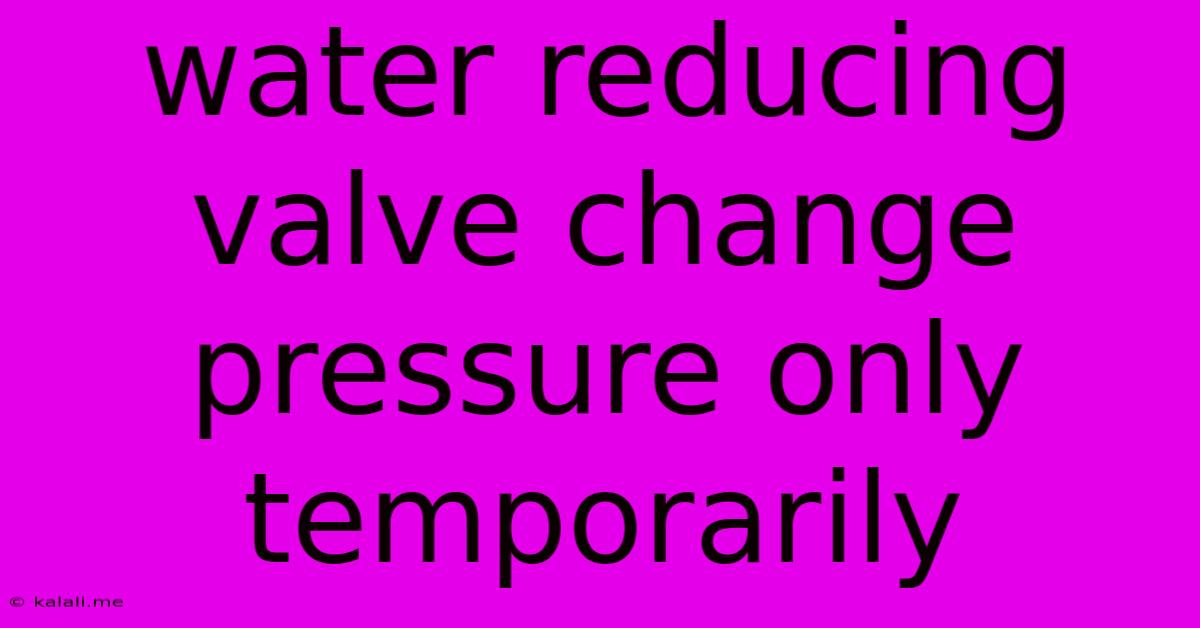Water Reducing Valve Change Pressure Only Temporarily
Kalali
Jun 10, 2025 · 3 min read

Table of Contents
Water Reducing Valve: Why Pressure Only Temporarily Decreases
A water reducing valve (WRV) is designed to maintain a consistent, lower water pressure downstream, protecting pipes and fixtures from high-pressure damage. However, sometimes you'll find the pressure reduction is only temporary. This article explores the common reasons why your WRV might only provide a short-term pressure decrease and how to troubleshoot this issue. Understanding these problems can save you from potential water damage and costly repairs.
Why Your Water Pressure Might Only Decrease Temporarily
Several factors can contribute to a WRV's inability to maintain consistent lower pressure. These issues often stem from problems within the valve itself or upstream in the water supply.
1. Internal Valve Problems:
-
Debris or Sediment Buildup: Over time, mineral deposits and sediment can accumulate within the valve's internal components, hindering its proper operation. This buildup restricts the valve's ability to regulate water flow, leading to temporary pressure drops as the valve struggles to function. Regular maintenance and flushing can prevent this.
-
Worn-out Internal Parts: The diaphragm, spring, or other internal parts of the WRV can wear down with age and use. This wear can cause inconsistent pressure regulation, resulting in temporary pressure reductions as the worn parts fail to properly control water flow. Replacing the entire valve is usually the best solution in this case.
-
Incorrect Valve Setting: The WRV may be improperly adjusted, leading to insufficient pressure reduction. Check the manufacturer's instructions to ensure the valve is set to the correct output pressure. A slight adjustment might restore consistent pressure regulation.
2. Upstream Water Pressure Fluctuations:
-
High Water Demand: During peak usage times (e.g., morning showers or evening dishwashing), increased water demand throughout the system can overwhelm the WRV's capacity to maintain the reduced pressure. This temporarily increases the downstream pressure until demand lessens.
-
Water Main Pressure Surges: Sudden increases in pressure from the main water supply can temporarily overcome the WRV's pressure reduction capabilities. This is often outside of your control, but consistent high pressure surges may warrant contacting your water utility company.
-
Leaky Fixtures or Pipes: Leaks in your plumbing system can increase the overall water demand, placing extra strain on the WRV and leading to temporary pressure drops as the valve struggles to compensate for the water loss. Identifying and repairing leaks is crucial to maintain consistent pressure.
3. Valve Sizing and Installation Issues:
-
Incorrect Valve Size: An improperly sized WRV (too small for the water flow demand) can struggle to adequately regulate pressure, resulting in temporary pressure reductions. Professional consultation to determine the correct valve size is recommended.
-
Incorrect Installation: If the WRV is not installed correctly according to the manufacturer's instructions, it may not function optimally, resulting in inconsistent pressure reduction. Verifying proper installation is critical.
Troubleshooting Steps:
-
Check the WRV's adjustment: Ensure the valve is set to the desired output pressure according to the manufacturer's instructions.
-
Inspect for leaks: Carefully check all pipes and fixtures for leaks that might be increasing water demand.
-
Flush the system: Run water through the system for several minutes to try and clear any debris that might be affecting the WRV.
-
Check water pressure at the main: Observe if the pressure fluctuations occur even before the WRV, indicating a problem with the main water supply.
-
Consider valve replacement: If the above steps don't resolve the issue, the WRV may need replacement due to worn-out parts or incorrect sizing.
A properly functioning WRV is essential for maintaining consistent water pressure and protecting your plumbing system. If temporary pressure reductions persist despite troubleshooting, it's best to consult a qualified plumber to diagnose and repair the problem. Ignoring the issue could lead to more significant problems down the line.
Latest Posts
Latest Posts
-
Gravy Is Not Meat Is Taste
Jun 10, 2025
-
Petcock Open Or Closed When Refueling Motorcycle
Jun 10, 2025
-
Tough Yoga Ball Chair That Can Servive Cats
Jun 10, 2025
-
Best Soil For Growing Aloe Vera
Jun 10, 2025
-
Why Is A Child Called Master
Jun 10, 2025
Related Post
Thank you for visiting our website which covers about Water Reducing Valve Change Pressure Only Temporarily . We hope the information provided has been useful to you. Feel free to contact us if you have any questions or need further assistance. See you next time and don't miss to bookmark.